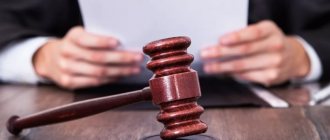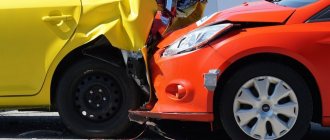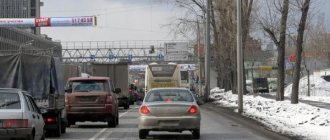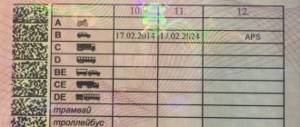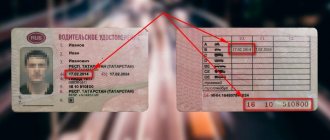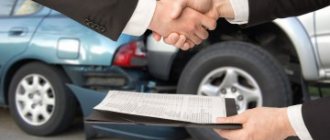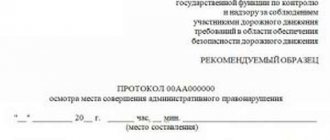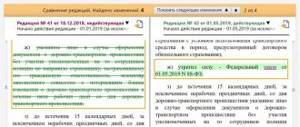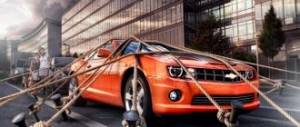Home/Damage to a car/Collection of damages from the culprit of an accident
Auto liability insurance is designed to protect the driver from having to independently compensate for the damage to the injured person. However, the amount of payment is limited. It may not be enough to completely close the obligations. In this situation, the law allows you to recover the remaining funds from the culprit of the incident. A similar rule applies in the case where a citizen does not have a compulsory motor liability insurance policy.
Attention
Recovery of damages from the culprit of an accident in 2021 can be carried out voluntarily or in court. The victim will have to prepare the evidence base and draw up a statement of claim.
Law on compensation for damage from the perpetrator of an accident
Compensation for damage caused during an accident is carried out in accordance with the provisions of the Civil Code. The rules regarding the implementation of the procedure in 2021 are set out in the following articles:
Attention! If you have any questions, you can chat for free with a lawyer at the bottom of the screen or call Moscow; Saint Petersburg; Free call for all of Russia.
- Article 15 - reflects the process of compensation for losses after an accident.
- Article 1064 - fixes the general grounds for liability for causing harm.
- Article 1083 - reflects the process of taking into account the guilt of the victim. There are also rules according to which the property status of the citizen who caused the harm is taken into account.
- Article 1094 - defines the process for reimbursement of funeral expenses.
The process is also regulated by Federal Law No. 40 On OSAGO. In particular, the responsibility that the driver bears to other road users is enshrined in Article 4 of the above-mentioned legal act. A number of provisions regarding compensation for damage are also present in paragraph 3 of Article 3 of Federal Law No. 4015-1 On the organization of the insurance business in the Russian Federation of November 27, 1992.
The amount of compensation due to the victim is determined in accordance with the norms of the Code of Administrative Offenses of the Russian Federation. Thus, Chapter 12 describes the possible consequences for a driver who violated traffic rules. Punishments depending on the type of violation are also presented here, as well as possible penalties and penalties are designed.
Attention
Sometimes an incident can have particularly serious consequences. This could result in significant harm or death to road users. This situation is regulated by criminal law.
Any accident that occurs on the road entails monetary losses. Sometimes additional damage to life, health or property is caused. The Civil Code of the Russian Federation provides persons who have suffered material losses with the right to full compensation for damage. The person responsible for the incident must compensate for the damage. The MTPL law obliges citizens to insure civil liability in advance. For this purpose, an agreement is concluded with the insurance company. It acts as a guarantee of providing compensation if damage is caused by a third party. The victim acquires the right to compensation for damages from the person responsible for the accident. Cash is provided for:
- damaged personal property;
- injuries inflicted that affected normal life or ability to work;
- loss of a breadwinner and to cover funeral costs;
- lost income as a result of disability.
For your information,
compulsory motor liability insurance compensates for the damage caused to the victim in an accident. The person at fault may have a CASCO policy. This type of insurance allows you to receive payment regardless of who caused the accident.
And if the accident is registered according to the European protocol?
The section has been updated in connection with the publication of the Resolution of the Plenum of the Supreme Court No. 58 of December 26, 2017.
In the case of the European protocol, legislation has changed greatly in recent years, either in one direction or in the opposite direction.
Let's explain what's going on here. It seemed, what difference does it make in the context of collecting wear and tear from the culprit, whether the accident was registered according to the European protocol or with the traffic police officers?! In both cases, compensation is made using the same method, and there are no disagreements with the Constitution and the Civil Code here.
But another legal act intervenes in the matter. We are talking about PPVS No. 2 dated January 25, 2015. Paragraph 39 of this resolution states a number of important facts:
- registration of a European protocol is a simplified form of receiving compensation under compulsory motor liability insurance,
- as a consequence, the very fact of simplification means the termination of any rights of claim both to the insurance company and to the culprit on the issue of wear and tear, after payment is made to the victim.
At the same time, there is a reference to Article 408 of the Civil Code, which essentially equates the European protocol to a kind of receipt that the culprit gives to the victim, and the victim receives payment on its basis, and after compensation is made, the execution is recognized as proper and complete.
Thus, until recently, judicial practice often equated the European protocol to a receipt stating that the victim has no claims against either the culprit or the insurance company. However, everything changed at the end of 2021, when the Supreme Court issued a new Plenum Resolution No. 58. In it, the PPVS of 2015 was declared invalid (clause 103 by reference). At the same time, the new document of the Supreme Court did not in any way express an opinion on the European protocol in the context of collecting the difference in wear and tear. Therefore, as of May 22, 2021, judicial practice works similarly to the usual registration of an accident with police officers.
Options for compensation for damage from the culprit of an accident in 2021
If a citizen has been injured as a result of an accident, experts advise not to delay in claiming compensation. In 2021, there are several legal methods for collecting money directly from the culprit of a traffic accident:
- Independently negotiate with the culprit of the incident. If agreement is reached, the decision is made in writing. It is recorded in the form of a receipt, which stipulates the transfer and receipt of money. Additionally, the fact that there are no claims is recorded.
- Submit a written complaint. The document is sent to the permanent registration address of the person responsible for the incident. Sending is made in the form of a registered letter. The document sets deadlines for fulfilling obligations for compensation for damage. If there is no response within the established period, you can prepare a claim and go to court.
- Claiming funds in court. The citizen will have to prepare the evidence base and draw up a statement of claim.
Required evidence for recovery
Order of the Ministry of Internal Affairs No. 664 of August 23, 2021 abolished the need to issue a certificate of an accident. All information about the incident is entered into the protocol. The document displays the date and time of the incident, the location of the incident, a list of persons who participated in the accident, a list of violations committed and their connection to the current legislation.
However, to successfully collect payment from the culprit of an accident, one protocol is not enough. Based on information agreed upon with all participants in the accident, the following data is recorded:
- Movement pattern. The location of each person at the time of the incident is documented.
- Evidence. They are attached to the protocol. Then the data about them is entered into the inventory.
- Photos or videos from the scene of the accident.
- Testimony of witnesses. They can help explain the events that occurred.
- Vision of events by a traffic police officer. The information is recorded in the report.
The protocol contains a column that lists the violations committed. The culprit may be subject to civil or administrative liability. If there is no basis, the case will not be initiated. Information about this is recorded in the protocol. Instead of a standard certificate, the traffic police officer provides other documents:
- A copy of the protocol. Issued at the scene of the accident.
- Resolution on the commission of an offense. The document is prepared in accordance with administrative regulations.
- The decision to initiate administrative proceedings based on the accident or refusal to carry out the process.
Based on interviews with witnesses, the following information must be recorded;
- Vehicle speed. If the exact value of the indicator is unknown, an approximate figure is indicated.
- The presence of a passenger in the car, the presence of heavy cargo or other features.
- Distance to the car at the moment when the victim realized the danger.
- Damaged vehicle components and the extent of their damage.
- Opinion about the correspondence of the accident location with the traffic pattern.
- The moment the driver takes measures to protect against a collision. This item indicates when the person tried to brake or turn the steering wheel. Then the approximate route to the collision is indicated.
Attention
When going to court in 2021 to recover damages from the culprit of an accident, the victim is obliged to attach to the claim the entire above list of documents and other evidence. Additionally, it is worth drawing up a petition to claim the administrative case that was initiated following the accident. The main evidence is an expert opinion. It is compiled based on the results of an assessment of the breakdown of vehicle components and the cost of work that is necessary to restore them.
Damage assessment in case of road accident
Before going to court to recover damages from the culprit of an accident in 2021, you must obtain an expert opinion. To do this, you will need to contact an independent company that has permission to conduct such events. The expert must fully determine the extent of damage caused to the car. This is a rather delicate process. The specialist must have skills and experience. The expert will determine the amount needed to compensate for the damage to the car.
To conduct an independent examination, you will need to prepare a package of documents. The list should include:
- PTS;
- protocol drawn up at the scene of the incident;
- STS;
- citizen identity card.
Please note:
The list of papers may vary depending on the internal policies of the selected organization. The examination takes up to 5 working days. It is possible to reduce the process to 1-2 days. However, expedited damage assessment may cost more.
What determines the amount of damage?
The amount of compensation for damage to a car from the culprit of an accident in 2021 is influenced by a list of factors. The following are taken into account:
- The price of parts damaged during an accident, taking into account depreciation, as well as the work itself to restore the car.
- Costs of conducting an expert assessment of damage to vehicles.
- If, as a result of an accident, there is total damage to property, the amount fixed in the purchase and sale agreement is reimbursed, taking into account depreciation, and not the price of the new car.
An accident may entail other material costs. The process of their collection and compensation is regulated by the Civil Code of the Russian Federation. The norms are enshrined in articles 1064 and 1072. You can demand the following payments from the culprit of the incident:
- money that had to be paid for calling a tow truck and subsequent parking of the damaged car;
- the amount for transporting victims to a medical facility;
- compensation for treatment, rehabilitation, purchase of medicines;
- wages lost as a result of inability to work;
- funeral services if the accident resulted in death.
Please note
: The amount of recovery from the culprit of the accident can also include payment for moral damage. Reimbursement is carried out in court if it is not possible to obtain voluntary consent to provide funds.
Insurance
A foreign investor or a subsidiary of a foreign investor that is a shareholder (participant) of an insurance organization that is a subsidiary of a foreign investor is not required to obtain prior permission from the Bank of Russia for the alienation of its shares (stakes) in the authorized capital of the insurance organization in favor of a third party - an affiliate of the foreign investor ( but not a subsidiary of a foreign investor) in accordance with the Directive of the Bank of Russia dated September 22, 2014 No. 3386-U. In accordance with the requirements of Article 32.10 of Law No. 4015-1, a transaction (transactions) for the acquisition by an individual or legal entity, including as part of a group of persons determined in accordance with the Federal Law of July 26, 2006 No. 135-FZ “On the Protection of Competition”, shares (stakes) of an insurance organization must be approved by the Bank of Russia if, as a result of one or more transactions, including as part of a group of persons, the size of such acquisition exceeds 10% of the shares (stakes) of the insurance organization. In accordance with the requirements of Bank of Russia Instruction No. 185-I dated December 25, 2017, transactions as a result of which other persons (group of persons) acquire (will acquire) ownership of shares (stakes) of a financial organization or the right to dispose of shares (stakes) of a financial organization and ( or) the right to use shares (stakes) of a financial organization (including those granted to a person under a contract (agreement) giving the person the authority to participate in the general meeting of shareholders (participants) of the financial organization and make decisions on an equal basis with other shareholders (participants) of the financial organization), require obtaining the preliminary consent of the Bank of Russia. The petition provided for by Instruction No. 185-I, with the necessary documents attached, is sent to the Bank of Russia by the person planning to complete the transaction. In accordance with Bank of Russia Regulation No. 626-P dated December 28, 2017, when considering the issue of issuing preliminary consent of the Bank of Russia for the acquisition of more than 10% of shares (interests) in insurance organizations, the financial position of legal entities and individuals planning to carry out these transactions is assessed. The business reputation of individuals or legal entities entering into a transaction aimed at acquiring more than 10% of shares (stakes) of an insurance organization, as well as individuals or legal entities exercising control over these legal entities, is also assessed.
Step-by-step instructions for recovering damages from the culprit of an accident peacefully
If the culprit of the incident does not have compulsory motor insurance, or the damage caused exceeds the permissible limit, the money will have to be recovered from the driver. In 2021, the process of compensation for damage from the culprit of an accident can be completed peacefully. To do this, it is recommended to try to negotiate. The procedure is called pre-trial recovery of damages. To oblige the culprit of the incident to provide payment, it is necessary:
- Get the protocol. The document contains information about all citizens who were involved in the accident. The registration addresses of all persons, the date and location of the incident, as well as the brands of cars involved in the incident are recorded there.
- Contact your own insurance company, request a certificate of possible compensation, or receive an official refusal to pay.
- Contact an independent expert company. The date for the examination will be set here. The other party must be notified of the procedure. Actions must be completed 3 days before the vehicle is inspected by an expert.
- Write a pre-trial claim. The document indicates the amount of funds requested, the method of calculation and the period within which funds must be provided. The claim must be supplemented by a package of documents.
- Wait for the specified period. If a person makes the calculation independently, the obligations are considered fulfilled. In other situations, it is recommended to go to court. Claims must be submitted only 7 days from the date of presentation of the claims.
IMPORTANT
The demand for recovery of damages from the culprit of the accident must be drawn up legally correctly. If there is no legal knowledge, you need to involve a car lawyer in the proceedings.
How to recover wear and tear from the culprit?
If you find yourself the injured party in an accident, then the instructions for collecting wear and tear under OSAGO are quite simple.
The situation with receiving compensation from the insurance company is standard:
- based on the documents and together with them, you submit an application for compensation under compulsory motor liability insurance to the insurance company,
- within 20 days after submitting all documents, the insurance company is obliged to make a payment or provide a referral for repairs (at its discretion),
- Based on the results of the payment, you understand that the amount is not enough, or the referral for repairs is accompanied by a requirement to pay extra to the car service center, since the latter’s employees do not agree to repair the car for the money that the insurance company transferred to them.
And now you have 2 options for collecting money.
First way
- you do not separately calculate the amount to be reimbursed, but instead receive a calculation in the insurance certificate - 2 amounts will always be indicated there: with and without wear; we have a special article on how to obtain an insurance calculation report,
- Next, you need to first of all invite the culprit to voluntarily offer to compensate the difference, taking into account wear and tear,
- in case of refusal, it is necessary to write a pre-trial claim to the culprit, where to provide the calculation, attach a copy of the insurance settlement report and offer to reimburse the specified amount within a reasonable time (usually indicated from 10 to 20 days),
- if the “pre-trial” is not satisfied, you should file a lawsuit against the culprit; the claim is filed in the magistrate’s court if the cost of the wear and tear dispute does not exceed 50 thousand rubles, or in the district court if it exceeds; the claim is filed at the location of the defendant - that is, at the registered address of the culprit.
Second way
The second option is similar to the first, with the only differences being:
- instead of receiving an insurance settlement report, you order an independent examination, as a result of which you receive a new assessment of the damage, which, as a rule, is higher than the insurance calculation, but the examination also costs some money (which, if the court wins, is also reimbursed by the culprit),
- submit a pre-trial claim to two addressees: to the insurance company - the difference between the amount paid, taking into account wear and tear, and calculated by an independent expert, also taking into account,
- to the culprit - the difference between the assessment of the amount without taking into account depreciation by an independent expert and the assessment taking into account depreciation according to the calculation also of an independent expert,
At the stage of filing a claim in court, we highly recommend contacting an expert lawyer, since writing a statement of claim itself is not an easy procedure, and in court there are still a number of subtleties that you need to know. So, at the request of the judge, you will need to confirm the actual costs of restoring the car.
Step-by-step instructions for compensation for damage from the culprit of an accident under compulsory motor liability insurance
The process of compensation for damage under compulsory motor liability insurance is regulated by Federal Law No. 40 of April 25, 2002. The procedure is as follows:
- The accident is documented. A traffic police officer takes part in the process. If conditions are present, the use of the Euro protocol is acceptable.
- The citizen notifies his insurance company about the incident. All further actions are carried out on behalf of the representative of the organization.
- The person prepares the necessary documents. The list of securities is reflected in clause 3.10 of the rules for OSAGO P-431. Additionally, an examination of the vehicle is carried out to determine the amount of damage caused to the vehicle.
- Based on the results of the procedures performed, a decision is made to provide compensation or refuse payment. If the decision is positive, payment is made to the insurer's account. The registration procedure is carried out at the organization’s office.
- Directions for repair work or payment of funds are provided.
Compensation for damage from the culprit of an accident under compulsory motor liability insurance is carried out only if the culprit of the accident has a valid contract on compulsory motor insurance. The payout limit is limited. In 2021, the insurance company can allocate up to 500,000 rubles for events related to health restoration. If we are talking about compensation for loss of property, the amount is limited to a limit of 400,000 rubles.
The main document required to receive payment is an application. It is submitted to the insurance company. The document must be completed correctly. Additionally, the following documents will be required:
- notification of an accident;
- completed protocol and resolution (if drawn up);
- a copy of the applicant's passport;
- PTS and STS;
- documented account number to which funds will be transferred;
- a copy of the refusal to initiate an administrative case, if the document has been completed.
to receive payment under compulsory motor liability insurance in WORD format.
Possibility of recourse from the insurance company
It is worth knowing in what cases the insurer has the right to recourse, and the list of situations is limited, which means that only in them, or rather, if they are proven, such claims may arise. The insurance company will make claims for compensation against the culprit in the following cases:
- In case of intentional harm to the life and health of the victim. That is, the driver had the intent to harm him. For example: he ran over a pedestrian on purpose, crashed into another car, etc.
- If the driver got behind the wheel while intoxicated, that is, an excess of the permissible alcohol limit was found in his blood, and in this state he got into an accident. At the same time, the insurance company can recover the costs incurred by it only if the fact of intoxication is documented and not disputed in court.
- The culprit fled the scene of the accident, even if he has compulsory MTPL insurance, he will probably be obliged to pay, but only under a recourse claim.
- The driver drove the vehicle without a license, or he is not included in the insurance if it is issued for a limited number of persons. Another situation is if the policy was not in force at the time of the accident. For example, it was issued for 3 months, and management took place after the expiration of this period.
- If the policy does not cover the territory of the country where the accident occurred.
- The insurance company will most likely file a claim with regressive claims if the driver of a taxi or bus had an overdue inspection at the time of the accident.
- You did not have your license with you at the time of the accident or it had expired, that is, more than 10 years have passed since the license was issued.
Recovery of damages from the culprit of an accident in excess of the limit under compulsory motor liability insurance
Federal Law No. 40 of April 25, 2002 established the maximum payment limit. Thus, compensation for damage to property cannot exceed 400,000 rubles. If harm was caused to a person’s health, the amount of payment increases to 500,000 rubles. However, compensation does not always cover the damage. As a result, the citizen has to independently pay for the purchase and installation of new units. Therefore, the amount of actual damage represents the amount of funds actually spent and the payment to the insurance company.
Attention
The resulting difference can be recovered from the culprit of the incident. The procedure for compensation for damage from the culprit of an accident in 2021 is carried out in court. To win the case, you need to provide a certificate from the insurers that allocated funds for repairs. Additionally, you will need documents from the service center documenting the real cost of completely restoring the car. A decision will be made based on the documents submitted. If it is positive, the person responsible for the incident will be required to pay the missing amount.
The insurance company recovers from the culprit of the accident
We have already discussed how, in certain cases, motorists who have suffered damage in an accident can recover from the insurance company money that has not been paid or has been underpaid by insurers. But sometimes the situation changes to the opposite - and the insurance company collects a certain amount from the culprit of the accident, which compensates for losses incurred due to payment of its obligations to the insured motorists who suffered damage in this accident.
How is this done?
Due to specific legal mechanisms called subrogation and recourse. Subrogation (translated from Latin as “replacement”) is the transfer to the insurer, who paid the insurance compensation to the victim, the right to demand compensation for this compensation from the person who caused the damage to the insured. That is, the same “replacement” of the creditor is carried out in the relationship between the victim and the culprit. Now the culprit is not directly indebted to the victim, but to the insurance company. This mechanism allows the policyholder to receive compensation for damages under CASCO upon the occurrence of an insured event and relieves him of all the hassle in relations with the culprit of the accident. And the insurance company (IC) retains its insurance reserves (reimbursing them at the expense of the culprit) for subsequent payments to the insured persons.
Specific example of subrogation:
A certain Ivanov crashed your car, which was insured under CASCO. You go to your insurance company and receive the amount needed for repairs, which the causer of the damage, Ivanov, actually owes you. Therefore, your insurance company now has the right to demand this debt from Ivanov. If Ivanov has an MTPL policy, his insurance company will pay for it. If the amount of insurance compensation for a motor vehicle does not cover the expenses, your insurance will recover the uncovered balance from the culprit - that is, the same Ivanov.
Recourse is a newly emerging legally justified right of return of a claim by the insurance company, which has compensated for damage under the insurance contract, to the person responsible for the damage. In this example, Ivanova Insurance Company, which made a payment under the MTPL policy to your insurance company, can exercise the right of recourse. Or, if you were not insured under CASCO insurance – for you personally. That is, Ivanov, having insured his liability, was freed from the need to compensate you for the damage. But according to the recourse mechanism, he has a new obligation - to pay off the insurer’s expenses. It must be borne in mind that the right of recourse arises only in cases strictly defined by law (Article 14 of the Law on Compulsory Motor Liability Insurance), the list of which is closed and cannot be expanded, say, in an insurance contract.
The right of recourse is established if:
- harm was caused to the life or health of the victim due to the intent of the perpetrator
- The culprit was driving while intoxicated
- the culprit did not have a license to drive the car that caused you damage; the culprit fled the scene of the accident
- the culprit is not included in the MTPL agreement as a person allowed to drive the insured car
- The accident occurred during the period when the policy was not in force (before the start of the policy, after the end, in the territory to which the policy does not apply, etc.).
Thus, the company that issued Ivanov the MTPL policy can exercise the right of recourse if Ivanov, for example, was drunk. If he committed an accident due to a sudden heart attack or even simply fell asleep at the wheel, it is illegal to demand compensation from him for the insurance company’s expenses.
What if you suddenly found yourself in Ivanov’s place?
And did you receive a claim from the insurance company based on the right of subrogation or recourse? Don’t despair, contact our lawyers – and together we will try to figure out how justified this claim is. After all, subrogation claims, like subrogation claims, must comply with certain norms and rules. If you properly build a line of defense, you can waive the claims of the insurance company from yourself, or reduce the amount of payments required from you.
And, unless you fled the scene, causing an accident, driving through a red light, being drunk, and at the same time deprived of your driver’s license, we have reason to believe that we can help you.
Call – and qualified lawyers are always at your service.
Step-by-step instructions for compensation for damage from the culprit of an accident through the court in 2021
IMPORTANT
Collection of funds from the culprit of the accident can only be carried out after he has been identified. The protocol records only the fact of violation. Guilt is determined in court.
To initiate proceedings, a citizen must go to court. You should not delay in collecting damages from the culprit of the accident through the court. The limitation period is 3 years. The rule is enshrined in Article 196 of the Civil Code of the Russian Federation. If the amount of damage does not exceed 50,000 rubles, an application must be submitted to a magistrate. If you request larger compensation, you must contact the district court. When filing a claim, you will have to pay a state fee. Its size depends on the amount collected. When going to court, you need to proceed according to the following scheme:
- Make a pre-trial claim. If there is no response, or the citizen refuses to compensate for the damage caused, you need to prepare a package of documents.
- Draw up a statement of claim and submit it to the court office. The document must be drawn up correctly. Errors will be grounds for denial of further proceedings.
- Receive a subpoena and appear at the hearing.
- Take part in the meeting.
- Wait for the decision to be made. If the verdict is positive, the citizen will be able to recover the funds.
for compensation for damages from the culprit of the accident in WORD format.
If the defendant is in no hurry to make a payment, enforcement proceedings can be initiated. The bailiff will give the citizen 10 days to voluntarily repay the debt. If the action is not carried out, it is permissible to confiscate part of the personal property to cover the obligations. Additionally, it is possible to force a portion of funds to be written off from all types of earnings. The money is transferred to the victim’s bank account. Details are indicated in the application to initiate enforcement proceedings. When payment is granted, the case is closed.
Grounds for recourse when recovering from the culprit of an accident
Recourse is the process of collecting the money that was spent by the insurance company to cover the expenses of the victim in an accident. This money is recovered in full from the culprit of the accident after the fact of guilt has been finally established.
The regression mechanism also has another name. In Article 14 this process is referred to as a reverse claim, and is part of the general system of motor vehicle liability. That is, in essence, this implies that the person (or organization) that paid the victim material compensation returns its funds by collecting from the person through whose fault the road accident occurred.
The insurance company recovers compensation from the culprit of the accident by way of recourse in any case. But most of our compatriots are unaware of this, since they are not always fully familiar with all the rules of car insurance. This leads to the fact that people who have an insurance policy and were involved in a road accident are confident that everything is fine, because they are insured. Therefore, the requirement of the insurance company to compensate for their damage is perceived by many people as an attempt to deceive on the part of the insurers.
Such a judgment always leads to consequences. Considering the fact that initially such a judgment is not correct, and the culprit of the accident will bear responsibility in any case, including financial responsibility. The insurance company pays for all the losses that the accident caused the victim, and it is quite natural that they will want to get their money back.
The Russian legislative framework provides the opportunity to recover funds from the responsible person through recourse. This mechanism is used in any conflict situation in which three parties are involved, one of which acts as a guarantor (insurance company). And if an insured event occurs due to the fault of one of the parties to the conflict, then the guarantor has every right to demand compensation from the culprit for all expenses that fall on him as a result of the accident.
It just so happens that in modern life we expect many situations when financial relationships between three parties go through a procedure such as regression. For example, this is a bank guarantee, the liability of third parties for the payment of debt obligations, as well as insurance issues. Debt collection through recourse often goes through the court, and the guarantor of financial stability (guarantor) will receive his funds back only after the court hearing and after the final verdict.
The trial procedure for returning money to the guarantor consists of several main stages.
- Formation of a claim by way of recourse for an accident, indicating all demands and claims against the defendant, as well as attached documents that confirm the financial expenses of the guarantor.
- Pre-trial settlement of the situation. At this stage, attempts are made to complete the process without involving the court, and an evidence base is formed, and grounds for recourse are identified.
- The judicial process itself, which involves considering all the circumstances of the conflict situation, and making a final decision on collecting money from the culprit of the accident or releasing him from financial responsibility.
Important! The recourse procedure is carried out exclusively according to the conditions set forth by law. And therefore, the right to reimbursement of monetary resources occurs only if the application and representation in court are carried out competently and in compliance with all standards.
The right to recourse compensation arises for certain reasons. Among the main circumstances that can lead to the initiation of the mechanism are:
- partial compensation for damage if there are several culprits for an accident on the road. In this case, all costs will be divided between them in equal proportions, and a certain amount will be collected from each;
- recovery under compulsory motor liability insurance. After a person’s guilt in an accident has been proven, the insurance company can file a claim against him for compensation of financial resources by way of recourse;
- compensation for damage to employees who suffered due to the fault of others. The employer can return the compensation paid and put forward demands according to which compensation for all damages will be assigned directly to the culprit of the accident;
- a demand from one family member to another for reimbursement of part of his costs for paying utility bills.
If the culprit of the accident is not the owner of the car
In practice, the vehicle may not be driven by its owner. The law allows this if the owner of the car has included the citizen in the MTPL policy, or the car was transferred on the basis of a long-term lease agreement. In this situation, responsibility for compensation for damage falls on the person responsible for the incident. There is no direct reference to this in civil legislation. However, judicial practice shows that courts find the person at fault who was driving the vehicle at the time of the accident. This does not take into account who really owns the car.
Regression is best avoided
In order to avoid the question of what to do after an accident and obtaining recourse, it is better not to give the insurance company a reason to file such a claim, but for this:
- Do not violate traffic rules and never drive while under the influence; it is better to call a taxi.
- Be careful on the road, because there are plenty of provocateurs and they often, as they say, set themselves up. Moreover, these could be pedestrians and other drivers.
- It is necessary to check the expiration date of the MTPL policy and renew it in a timely manner.
- When driving a truck, special equipment, taxi, bus, monitor the maintenance period.
- Make sure that the MTPL policy contains your own surname if the vehicle is driven by several people.
- To drive someone else's car, you must have a general power of attorney.
- If an accident does occur, then under no circumstances should you leave the scene of the accident.
Compensation for damage from the culprit of the accident, taking into account wear and tear or without taking into account wear and tear
The new edition of Federal Law No. 40 on compulsory motor liability insurance states that compensation will not be provided in cash. The money can be used for repairs. The price is set depending on the degree of wear of the damaged components. The payment amount cannot exceed 400,000 rubles. The older the car, the less money the insurer will provide.
However, it is almost impossible to carry out actual repairs for the amount provided. Therefore, the person is forced to pay from personal funds. The missing amount can be recovered from the culprit of the incident. The procedure is performed after the repair is completed. You will have to pay some of the funds yourself. When the car is repaired, you need to obtain a certificate confirming the amount of repair costs. The document is obtained from the insurance company. The certificate reflects the amount of payment provided by the institution. The papers are attached to the statement of claim and submitted to the court.
Court decisions
Usually the court makes a decision in favor of the policyholder. The culprit of the traffic accident is obliged to provide funds. However, the plaintiff is obliged to comply with all established norms and formalities.
Insurance companies have the right to put forward counterclaims. This is permitted if the offense was committed while drunk or under the influence of drugs. In this situation, regression operates. A similar rule applies if the victim was provided with payment, and the person responsible for the incident did not have compulsory insurance. In 2021, a citizen is automatically found guilty of an incident in the following situations:
- the car was driven by a person who does not have a license or was unable to pass a test on knowledge of traffic and driving rules;
- the driver was a citizen who was deprived of access to control the car;
- the person had a driver’s license, but it was issued for a different category of vehicle;
- the citizen deliberately fled the scene.
Attention:
If the culprit of the incident is not included in the insurance, a counterclaim for damages must be filed.
In what cases can the insurance company force the person at fault to pay for the accident?
Where is it stated that the insurance company has the right to demand money from the car owner?
The insurer’s right to demand compensation for the damage it has paid is regulated by Federal Law No. 40 “On compulsory insurance of civil liability of vehicle owners,” and specifically by the corresponding Article 14, which establishes “the insurer’s right of recourse against the person who caused the harm.” Now let's look at this article point by point and find out all the cases when the culprit of an accident can be forced to compensate the costs of the insurance company.
If the culprit of the accident intentionally caused harm to the life and health of the victims
Subparagraph “a” of paragraph 1 of Article 14 indicates that “the right of claim of the victim against the person who caused the harm, in the amount of the insurance compensation provided to the victim, is transferred to the insurer who made the insurance compensation, if, due to the intent of the said person, harm was caused to the life or health of the victim.” In other words, if, when studying the circumstances of an accident, it is established that the culprit of an accident with injuries or deaths acted intentionally, the insurance company has the right, through the court, to recover from him in full all the compensation payments that it has made.
If the culprit of the accident was drunk
Subparagraph “b” establishes the insurer’s right to a recourse claim against the culprit of the accident if “the damage was caused by the specified person while driving a vehicle while intoxicated (alcohol, drugs or other).” That is, drunken culprits of an accident will pay for everything themselves - firstly, the insurance company will claim from them all the money paid to the victims, and secondly, the victims have the right to demand from them additional compensation for damage that was not covered by the maximum insurance payment.
Unfortunately, at the moment there is still a loophole for drunk drivers: those who refused to be examined or deliberately consumed alcohol after an accident are not considered drunk. However, from October 29, 2021, amendments will come into force that will eliminate this shortcoming: subparagraph “b” will include cases where “the specified person did not comply with the requirement of an authorized official to undergo a medical examination for intoxication or he did not comply with the requirement of the Traffic Rules of the Russian Federation on prohibiting a driver from consuming alcoholic beverages, narcotic or psychotropic substances after a traffic accident in which he is involved.”
If the culprit of the accident did not have the right to drive the car he was driving
Subclause “c” states that the insurer can demand compensation from the culprit of the accident if he “did not have the right to drive the vehicle during the use of which he was harmed.” The wording is quite broad: it includes both drivers who have been deprived of their license and those who, for example, drove a car of a category that is not open to the current license.
If the culprit of the accident fled the scene of the accident
Subparagraph “d” indicates the possibility of a recourse claim against the culprit of the accident if he fled the scene of the traffic accident. Of course, this will require identifying the culprit, which is what some cowardly individuals take advantage of, trying to avoid deserved punishment. However, if the culprit of the accident is found, he will bear full financial responsibility for what he did.
If the culprit was not included in the insurance
We mentioned this option in a separate article: subparagraph “e” establishes the insurer’s right to compensation for its expenses if the culprit’s car was insured, but the culprit himself was not included in the current insurance policy. Of course, we are talking only about so-called “closed” or “limited” MTPL policies - if it was concluded in relation to an unlimited number of persons, the insurance company is obliged to compensate for the damage independently.
If the person at fault for the accident did not provide the car for inspection to the insurer
Article 11 of the law on compulsory motor liability insurance establishes the responsibilities of drivers in case of an accident: in particular, the culprit is obliged to notify his insurance company about the accident within 5 working days and not begin repairing or disposing of the damaged car for 15 days after it, since the insurer has the right to demand during this period carrying out its inspection or technical examination. Subparagraph “h” of Article 14 establishes the possibility of a recourse claim from the insurance company to the perpetrator if “before the expiration of 15 calendar days, with the exception of non-working holidays, from the date of the road traffic accident, the specified person in the event of registration of documents about the road traffic accident without the participation of authorized Therefore, the police officers began to repair or dispose of the vehicle, during the use of which they were harmed, and (or) did not present this vehicle at the request of the insurer for inspection and (or) independent technical expertise.” Simply put, if the person at fault for the accident begins repairing or disposing of the car in which he was involved in an accident before the expiration of 15 business days, the insurance company may require him to compensate for his payments to the victims.
If the person at fault for the accident provided incorrect information when concluding the MTPL agreement
Another subparagraph under the letter “k” establishes the liability of the culprit of the accident, even if he was included in the current OSAGO policy, but when purchasing this policy online, false data was provided in order to reduce its price. As you know, the final cost of the policy is influenced by different coefficients - territorial, age, and so on, and if one of them turns out to be incorrect, which makes the policy cheaper, then such a small “saving” can result in much more serious costs in the event of an accident.
Other cases
In addition to the cases discussed above, paragraph 1 of Article 14 contains two more subparagraphs that are not relevant for car owners. Thus, subparagraph “i” establishes the possibility of a recourse claim by the insurance company against the culprit of the accident if he is the driver of a passenger taxi, bus, truck equipped for passenger transportation, or a vehicle for transporting dangerous goods, if the specified vehicle does not have a valid diagnostic card. Owners of the above cars are required to undergo technical inspection twice a year, and an up-to-date diagnostic card is a prerequisite for making insurance payments.
The second subparagraph that we will mention here has not yet entered into force: the paragraph under the letter “l” will become relevant from October 29, 2021. It indicates that the insurance company has the right to a recourse claim against the person who caused the accident if “the damage was caused by the specified person when using a vehicle with a trailer, provided that the compulsory insurance contract does not contain information about the possibility of driving a vehicle with a trailer, with the exception of trailers for passenger cars owned by citizens.” It is worth paying attention to the very end of the wording: trailers for passenger cars are not among the grounds for litigation - here we are talking about trucks and trailers for them, which must appear in the MTPL policy.
Nuances
The law allows you to recover damages from the culprit of a traffic accident in 2021 if there are legal grounds for performing the procedure. The action is carried out if the amount of damage exceeds the amount stipulated by the policy. In this case, the second party may try to refuse to cover the damage caused to the car by proving that the demand presented is illegal. You can solve the problem peacefully by trying to agree on a reduction in the amount of the penalty. It is quite possible to receive money from the culprit of the incident. However, the citizen must be prepared for the fact that time will be required. Legal knowledge is required to complete the procedure.
| Question | Answer |
| The amount of damage exceeded insurance coverage. Is it possible to recover the balance from the culprit? | Yes, the law allows the action to be performed. |
| To which court should a claim for damages be filed against the person at fault for an accident in 2021? | If the claim does not exceed 50,000 rubles, the magistrate court will consider the issue. In all other cases, you need to submit an application to the district authority. |
| How many days after filing a claim can I go to court? | The debtor must be given a minimum of 7 days. |
| Do I need to hire a professional damage assessor? | Yes, without its conclusion, the claims will be unfounded. |
| Is it possible to recover payment for moral damages from the culprit of an accident? | Yes, this is acceptable. |
Comments Showing 0 of 0
